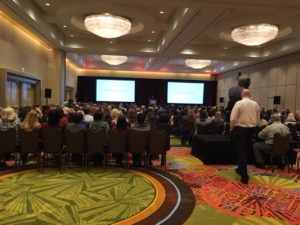When I was a teenager one of my idols was Maria Shriver, a fact I’d long forgotten until my mother reminded me earlier this year as we watched a documentary about photojournalist James Foley. While I had dreams of becoming a broadcast journalist, I wasn’t sure I would be comfortable asking people to answer questions they didn’t want to be asked. So when I landed in journalism school at the University of Maryland, I chose the public relations track.
That never-pursued aspiration might explain why I jump at any chance to interview my clients or my clients’ stakeholders. Whether we’re crafting a story, producing a podcast, or shooting a video, I’m the first one to throw my wannabe journalist hat into the ring. I had one of those opportunities earlier this week.
My client, Ortho Clinical Diagnostics, was hosting a customer event at the American Association of Blood Banks annual conference. They invited two laboratory professionals from Orlando Regional Medical Center to talk about how they implemented their Mass Transfusion Protocol after the Pulse nightclub massacre in June. The more than 300 attendees at their session gave them a well-deserved standing ovation for their critical role in saving the lives of 44 trauma patients who were brought to their hospital that night. After their speech, I sat down with them to conduct an interview that will air later on our client’s online thought leadership platform, ORTHO ON DEMAND.

I’ve come to learn that the people who run the transfusion medicine department at hospitals are the unsung heroes of healthcare. They are responsible for running screens and matching types for patients who are often in desperate need of blood. They must be swift and accurate in their work in order for the surgeons and the rest of the medical staff to perform the miracles that enable people to walk out of the hospital after a devastating injury or a major surgery.
Carol Fortier and Lourdes Miller of the Orlando Regional Medical Center were no different. In our interview, they talked about how they mobilized people in the middle of the night to handle the crisis, the ways they kept themselves going without taking a break, how they managed to avoid making mistakes that could cost lives and the steps they’ve taken to care for the mental health of their team in the aftermath. It was an honor and privilege to sit there under bright lights and with cameras rolling to ask them these questions. Some were tough to answer as the feelings of that night rushed back. Both occasionally paused to fight back tears.
When the interview ended and the cameras were turned off, we stood up and hugged. Even our make-up artist, an Orlando resident, came over to hug Carol and Lourdes, thanking them for their tireless efforts to save so many lives. I thanked them for telling their story to me, even if it was difficult. Their team may have saved 44 lives that night, but they have a chance to save hundreds or even thousands more by sharing their story. And I’m proud to have played a small role in making it happen.
